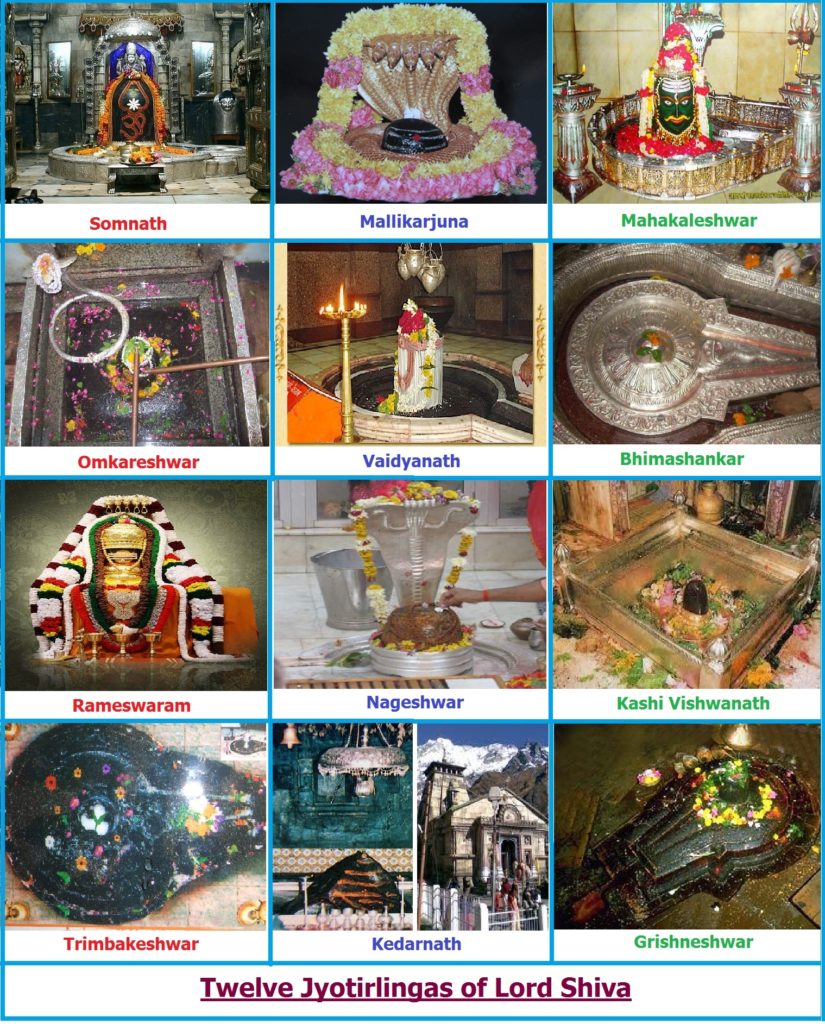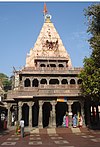 A Jyotirlinga or Jyotirling or Jyotirlingam (Sanskrit: ज्योतिर्लिङ्ग) are shrines where Lord Shiva, is worshipped in the form of a Jyotirlingam. ‘Jyothi’ means ‘Radiance’ and Lingam, the Shiva Lingam-‘the mark or sign’ of The Almighty or the phallus symbol. Jyotir Lingam means the The Radiant sign of The Almighty. There are twelve traditional Jyotirlinga shrines in India.
A Jyotirlinga or Jyotirling or Jyotirlingam (Sanskrit: ज्योतिर्लिङ्ग) are shrines where Lord Shiva, is worshipped in the form of a Jyotirlingam. ‘Jyothi’ means ‘Radiance’ and Lingam, the Shiva Lingam-‘the mark or sign’ of The Almighty or the phallus symbol. Jyotir Lingam means the The Radiant sign of The Almighty. There are twelve traditional Jyotirlinga shrines in India.
Lord Shiva first manifested himself as a Jyotirlinga on the night of the, Aridra Nakshatra thus the special reverence for the Jyotirlinga. There is nothing to distinguish the appearance, but it is believed that a person can see these lingas as columns of fire piercing through the earth after he reaches a higher level of spiritual attainment. There are twelve Jyotirlingas in India and they are spread all over India.
As per Shiv Mahapuran, once Brahma (the God of creation) and Vishnu (the God of Preservation) had an argument in terms of supremacy of creation. To test them, Shiva pierced the three worlds as a huge endless pillar of light, the jyotirlinga. Vishnu and Brahma split their ways to downwards and upwards respectively to find the end of the light in either directions. Brahma lied that he found out the end, while Vishnu conceded his defeat. Shiva appeared as a second pillar of light and cursed Brahma that he would have no place in ceremonies while Vishnu would be worshipped till the end of eternity.
The jyotirlinga is the supreme partless reality, out of which Shiva partly appears. The jyothirlinga shrines, thus are places where Shiva appeared as a fiery column of light. Originally there were believed to be 64 jyothirlingas while 12 of them are considered to be very auspicious and holy. Each of the twelve jyothirlinga sites take the name of the presiding deity – each considered different manifestation of Shiva. At all these sites, the primary image is lingam representing the beginningless and endless Stambha pillar, symbolizing the infinite nature of Shiva. The twelve jyothirlinga are Somnath in Gujarat, Mallikarjuna at Srisailam in Andra Pradesh, Mahakaleswar at Ujjain in Madhya Pradesh, Omkareshwar in Madhya Pradesh, Kedarnath in Himalayas, Bhimashankar in Maharashtra, Viswanath at Varanasi in Uttar Pradesh, Triambakeshwar in Maharashtra, Vaidyanath Jyotirlinga at Deogarh in Jharkhand, Nageswar at Dwarka in Gujarat, Rameshwar at Rameswaram in Tamil Nadu and Ghushmeshwar at Shiwar in Sawai Madhopur district Rajasthan, 12th joytrilinga is Grishneshwar at ellora in aurangabad district Maharashtra.
The following sanskrit sloka ( द्वादश ज्योतिर्लिंग स्तोत्रम्) (Dwadasha Jyotirlingum Strota) describes about the 12 Jyotirlingas –
सौराष्ट्रे सोमनाथं च श्रीशैले मल्लिकार्जुनम्। उज्जयिन्यां महाकालमोङ्कारममलेश्वरम्॥
परल्यां वैद्यनाथं च डाकिन्यां भीमशङ्करम्। सेतुबन्धे तु रामेशं नागेशं दारुकावने॥
वाराणस्यां तु विश्वेशं त्र्यम्बकं गौतमीतटे। हिमालये तु केदारं घुश्मेशं च शिवालये॥
एतानि ज्योतिर्लिङ्गानि सायं प्रातः पठेन्नरः। सप्तजन्मकृतं पापं स्मरणेन विनश्यति॥
एतेशां दर्शनादेव पातकं नैव तिष्ठति। कर्मक्षयो भवेत्तस्य यस्य तुष्टो महेश्वराः॥:
द्वादश ज्योतिर्लिंग स्तोत्रम्
English Conversion
“Saurashtre Somanathamcha Srisaile Mallikarjunam|
Ujjayinya Mahakalam Omkaramamaleswaram ||
Paralyam Vaidyanathancha Dakinyam Bheema Shankaram |
Setu Bandhethu Ramesam, Nagesam Darukavane||
Varanasyantu Vishwesam Tryambakam Gautameethate|
Himalayetu Kedaaram, Ghrishnesamcha shivaalaye||
Etani jyotirlingani, Saayam Praatah Patennarah|
Sapta Janma Kritam pApam, Smaranena Vinashyati||”
English Translation(Literal)
Somanath in Saurashtra and Mallikarjunam in Shri-Shailam. (सौराष्ट्रे सोमनाथं च श्रीशैले मल्लिकार्जुनम्).
Mahakaal in Ujjain and Amleshwar in Omkareshwar. (उज्जयिन्यां महाकालमोङ्कारममलेश्वरम्).
Vaidyanath in Paralya and Bhimashankaram in Dakniya. (परल्यां वैद्यनाथं च डाकिन्यां भीमशङ्करम्).
Rameshem (Rameshwaram) in Sethubandh and Nageshem (Nageshwar) in Darauka-Vana. (सेतुबन्धे तु रामेशं नागेशं दारुकावने).
Vishwa-Isham (Vishvanath) in Vanarasi and Triambakam at bank of Gautami River. (वाराणस्यां तु विश्वेशं त्र्यम्बकं गौतमीतटे)).
Kedar (Kedarnath) in Himalayas and Gushmesh (Gushmeshwar) in Shivalaya (Shiwar). (। हिमालये तु केदारं घुश्मेशं च शिवालये).
One who recites these Jyotirlingas every evening and morning. (एतानि ज्योतिर्लिङ्गानि सायं प्रातः पठेन्नरः।).
He is relieved of all sins committed in past seven lives.(सप्तजन्मकृतं पापं स्मरणेन विनश्यति)
One who visits these, gets all his wishes fulfilled (एतेशां दर्शनादेव पातकं नैव तिष्ठति)
and one’s karma gets eliminated as Maheshwara gets satisfied to the worship:(कर्मक्षयो भवेत्तस्य यस्य तुष्टो महेश्वराः)

The names and the locations of 12 other ‘Jyotirlingas are mentioned in the Shiva Puran (Śatarudra Saṁhitā,Ch.42/2-4). These shrines are:
| # | Jyotirlinga | Image | State | Location | Description |
|---|---|---|---|---|---|
| 1 | Somnath |  |
Gujarat | Prabhas Patan,Saurashtra | Somnath is traditionally considered the first pilgrimage site: the Dwadash Jyotirlinga pilgrimage begins with the Somnath Temple. The temple, that was destroyed and re-built sixteen times, is held in reverence throughout India and is rich in legend, tradition, and history. It is located at Prabhas Patan (Somnath – Veraval) in Saurashtra in Gujarat. |
| 2 | Mallikārjuna |  |
Andhra Pradesh | Srisailam | Mallikārjuna, also called Śrīśaila, is located on a mountain on the river Krishna.[8] Srisailam, in Kurnool District in Andhra Pradesh enshrines Mallikarjuna in an ancient temple that is architecturally and sculpturally rich.It is one place where Shakti peeta and Jyotirlingam are together. Adi Shankaracomposed his Sivananda Lahiri here.[citation needed]. It is also one of the Padal Petra Stalam of Vada Naadu mentioned in Thevaaram. |
| 3 | Mahakaleshwar |  |
Madhya Pradesh | Ujjain | Mahakal, Ujjain (or Avanti) in Madhya Pradesh is home to the Mahakaleshwar Jyotirlinga temple. The Lingam at Mahakal is believed to be Swayambhu, the only one of the 12 Jyotirlingams to be so. It is also the only one facing south and also the temple to have a Shree Yantra perched upside down at the ceiling of the Garbhagriha (where the Shiv Lingam sits).It is one place where Shakti peeta and Jyotirlingam are together |
| 4 | Omkareshwar |  |
Madhya Pradesh | Island in theNarmada River,Omkareshwar | Omkareshwar in Madhya Pradesh on an island in the Narmada River is home to a Jyotirlinga shrine and the Mamaleshwar temple. |
| 5 | Kedarnath |  |
Uttarakhand | Kedarnath | Kedarnath in Uttarakhand is revered as the northernmost and the closest Jyotirlinga to Lord Shiva’s eternal abode of Mount Kailash. Kedarnath forms a part of the smaller Char Dham pilgrimage circuit of Hinduism. Kedarnath, nestled in the snow-clad Himalayas, is an ancient shrine, rich in legend and tradition. It is accessible only by foot, and only for six months a year. It is also one of the Padal Petra Stalam of Vada Naadu mentioned in Thevaaram. |
| 6 | Bhimashankar |  |
Maharashtra | Bhimashankar | Bhimashankar is very much debated. There is a Bhimashankara temple near Pune (pictured) in Maharashtra, which was referred to as Daakini country, but Kashipur in Uttarakhand was also referred to as Daakini country in ancient days and a Bhimashkar Temple known as Shree Moteshwar Mahadev is present there. Another Bhimashankar is in the Sahyadri range of Maharashtra. The Bhimashankar temple[9] near Guwahati, Assam is the jyotirlinga according to Sivapuran.According to “LINGA PURAN”, Bhimasankar temple in Bhimpur near Gunupur of Rayagada district in South Orissa is also believed as Bhimasankar Jyotirlinga, which is situated at the western part of the holy Mahendragiri mountains and at the river bank of Mahendratanaya(which is also believed as the Daakini area by many historian), was excavated in the year 1974, having quadrangular Shakti around the Linga and decorated by a Upavita as per the puran.[10] |
| 7 | Visheakarmeshwar |  |
Uttar Pradesh | Varanasi | Kashi Vishwanath Temple in Varanasi, Uttar Pradesh is home to the Vishwanath Jyotirlinga shrine, which is perhaps the most sacred of Hindu shrines. It is also one of the Padal Petra Stalam of Vada Naadu mentioned in Thevaaram. |
| 8 | Trimbakeshwar |  |
Maharashtra | Trimbakeshwar, Near Nashik | Trimbakeshwar Temple, near Nasik in Maharashtra, is a Jyotirlinga shrine associated with the origin of the Godavari river. |
| 9 | Baidyanath Jyotirlinga |  |
Jharkhand | Deoghar | Baidyanath Jyotirlinga temple is located in Deoghar District in Jharkhand . In the month of Shravana millions of devotee visit the temple.Bholebaba darshan during Shravan month attracts devotees from across India and overseas.It is believed that once Ravan worshipped Shiva for years and requested his god ( Shiva) to come to Lanka . Shiva manifested as shivaling and asked Ravan to not to put down anywhere until he takes it to Lanka. Vishnu intercepted Ravana in between and convinced him to keep it for sometime. Since then shiva resides as Baidyanath in Deoghar. |
| 10 | Nageshvara Jyotirlinga |  |
Uttarakhand | near Almora | Nageshvara Jyotirlinga is located among a cluster of 124 large and small historical stone temples inJageshwar, Almora district, Uttarakhand. Once the centre of Lakulish Shaivism, Jageshwar is located at an altitude of 1870 mts, in the Jataganga river valley near a Deodar forest (Cedrus deodara) starting from Artola village on Almora–Pithoragarh highway, where two streams Nandini and Surabhi flow down the hills in the narrow valley and meet near the sacred spot.Believed to be the site of the first of the twelve Jyotirlingas, Nageshvara Jyotirlinga, Jageshwar holds the ‘Jageshwar Monsoon Festival’ during the Hindu calendar month of Shravan and the annual ‘Maha Shivratri Mela’ (Shivratri festival) during spring. |
| 11 | Rameshwar |  |
Tamil Nadu | Rameswaram | Rameswaram in Tamil Nadu is home to the vast Ramalingeswarar Jyotirlinga temple and is revered as the southernmost of the twelve Jyotirlinga shrines of India. It enshrines the Rameśvara (“Lord of Rama”) pillar.[11] It is also one of the Padal Petra Stalam of Pandya Naadu mentioned in Thevaaram. |
| 12(b) | Grishneshwar | Maharashtra | Ellora caves | Grishneshwar Jyotirlinga shrine, at a village called Verul which lies at a distance of 11 km from Daulatabad and 30 km from [Aurangabad]. It lies at a close proximity to the Ellora caves.more information http://www.jyotirlingas.com/grishneshwar-jyotirlinga.html |
Some of the other major Shiva temples that are not listed as Jyotirlingas are Amarnath in Jammu and Kashmir, India , Pashupatinath in Kathmandu, Nepal ,